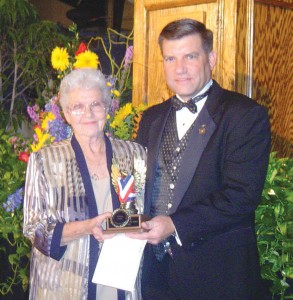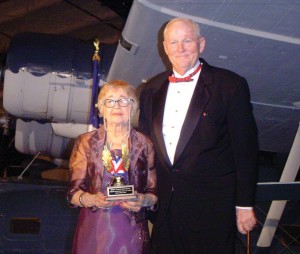
Ralph Royce, president of Lone Star Flight Museum, acts as emcee at the Texas Aviation Hall of Fame Induction Ceremony & Gala.
The Texas Aviation Hall of Fame inducted the Class of 2005 at the 7th annual Induction Ceremony and Gala on November 12. The inductees are Gordon Francis Baxter, Emma Carter Browning, Wallace Scott, Lance Wade and H.B. “Pat” Zachry. Baxter, Wade, Zachry and Scott were enshrined posthumously.
Emma Carter Browning
Emma Carter Browning was born in 1910 in Eastland, Texas. She bought her first airplane ride from a traveling barnstormer in 1929 for a dollar. In 1930, she met and married Robert Browning Jr., a daredevil pilot and former airport owner.
Barnstorming air shows was commonplace during the depression and the Brownings were part of that glamorous but dangerous activity. They performed aerobatic shows, parachute jumps and dead-stick landings to entice the public to purchase a ride.
The Brownings moved to Austin in 1939, where they leased University Airport and began Browning Aerial Services. As a member of the War Training Service, Browning Aerial Services trained pilots for the U.S. Army Air Corps. During that period the Brownings began their extensive involvement promoting general aviation interests.
In 1940, they formed the Texas Flight Training Association, along with four other fixed base operators. In the early 1960s, Emma Carter Browning was the force behind legislation allowing general aviation pilots to receive a rebate of the highway tax portion of their aircraft fuel bills.
When Robert Browning died in 1973, Emma Carter Browning became president of Browning Aerial Services. She remains focused on preserving the rich history of aviation in Texas. She’s the inspiration and benefactor behind the Texas Aviation Historical Museum in Austin, which will house her vast collection of aviation memorabilia.
Gordon Francis Baxter
Gordon Francis “Bax” Baxter was born on Christmas in 1923 in Port Arthur, Texas. He spent his life in the Beaumont area. As a young boy he admired the barnstormers who toured across southeast Texas. He developed an appreciation for the colorful aviation personalities and their experiences.
During the early days of WWII he was a Merchant Marine officer, but after Pearl Harbor he joined the Army Air Corps, serving as a B-17 waist gunner. In 1945 he became an announcer for KPAC radio, beginning a broadcast career that spanned 40 years. He was a homespun, outspoken and sometimes controversial disc jockey who earned a reputation for precise reporting.
In 1957 he began reporting for nine newspapers in the Texas/Louisiana area and writing regular columns. He also soloed that year. In 1970, through a chance encounter with the editor, Baxter became a columnist for Flying Magazine. His column, “Bax Seat,” ran for almost 28 years and established him as a unique and cherished voice in aviation.
Baxter was a three-time recipient of the Aviation/Space Writer Association’s citation for Outstanding Excellence in Journalism. The EAA and Flying Magazine award an annual trophy and honorarium in his name to an aspiring writer each year. The Federal Aviation Administration named an air traffic control electronic in-flight navigation point “Baxter Intersection.”
Although terribly ill when notified of his induction into the Texas Aviation Hall of Fame, Baxter replied, “Get my tux!” He passed away on June 11, 2005.
Wallace Scott
Wallace “Wally” Scott was born on Independence Day in 1924 at Van Horn, Texas. His flying career began when he was 18. At the age of 19, he became a civilian instructor for the Army Air Force Training Command at Ft. Stockton, Texas.
After joining the Ferry Command he flew numerous types of military aircraft across the United States before being transferred to Europe. During the Battle of the Bulge, he flew troops and supplies to the front and returned with wounded soldiers bound for hospital care, concluding his Ferry Command flying in the China-Burma-India Theater. His experience as a ferry pilot–where detailed preparation and a thorough understanding of weather conditions was key to success and survival–laid the groundwork for his later success in aviation.
In 1961 he took his first sailplane ride. Before his last sailplane flight in 1998 he logged 6,500 hours in sailplanes and nearly 300,000 miles of cross-country soaring. He won the Barringer Trophy for the longest sailplane flight of the year an unequaled 21 times and set four world sailplane records and numerous national and state records. He’s the only man to have simultaneously held all three recognized world distance records for sailplanes: straight-line distance, straight-line distance to a goal and return, and straight-line distance to a declared goal. He accomplished that feat twice.
In recognition of his remarkable soaring achievements, Scott’s sailplane was displayed at the Smithsonian Air and Space Museum in Washington, D.C.
L.C. “Lance” Wade
L.C. “Lance” Wade was born in 1916 on a farm in Broaddus, Texas. In 1934, he enlisted in the Civilian Conservation Corps. During his CCC enlistment, Wade and some friends purchased a plane and learned to fly. By 1940, he had a pilot license and sufficient flying time to join the Army Air Corps but was disqualified since he lacked a college degree.
Britain’s Royal Air Force was hiring pilots so he enrolled as a cadet in the United Kingdom Refresher Course in Tulsa, Okla. He completed training and was posted to England. Flying the Hawker Hurricane, Wade completed operational training and was sent to the Middle East. He traveled there on the British aircraft carrier Ark Royal, which was ferrying Hurricanes to the besieged island of Malta. Wade flew one of the Hurricanes off the Ark Royal to Malta and was then transported to Egypt to join 33 Squadron.
On his 25th birthday he shot down two Italian CR-42s and began his climb to become one of the RAF’s greatest fighter aces and the highest scoring American ace to fly completely with the forces of another country. When Wade came back to the U.S. in October 1942, he had 15 confirmed victories.
He returned to the Middle East to take command of 145 Squadron, flying Spitfires. Under his leadership, it became one of the most honored RAF squadrons in the Mediterranean Theater. He was promoted from a pilot officer (“on probation”) to flight commander, squadron leader and wing commander.
On Jan. 12, 1944, Wade died in a tragic aircraft accident in Foggia, Italy. At the time of his death he was credited with 25 aircraft destroyed in the air, and one destroyed and five damaged on the ground. In recognition of Wade’s leadership and combat achievements, the RAF posthumously bestowed on him the Distinguished Service Order (the second highest British military honor) and the Distinguished Flying Cross with two bars.
Wade was buried with full military honors in a British cemetery in Italy. After the war his remains were returned to the U.S. with a military honor guard. He now rests in the family plot in McKnight Cemetery, Cushing, Texas. The Lone Star Flight Museum’s Hawker Hurricane and Supermarine Spitfire pay tribute to this Texas hero by being painted in Lance Wade’s livery.
H.B. “Pat” Zachry
Henry Bartell “Pat” Zachry was born in 1901 in Uvalde, Texas. In 1922, he earned his bachelor’s degree from Texas A&M and began working for the Texas Highway Department. Within two years he left the highway department and started the H.B. Zachry Company.
The company had initial assets of $17,000 and 16 employees. From that modest beginning, Zachry built an international construction company known today as Zachry Construction Corporation, which employs 11,500 people with annual revenues well over $1 billion.

L to R: Boots Scott accepts the award for her late husband, inductee Wallace Scott, from Tom Gregory, a 10,000-hour volunteer who was also recognized.
The H.B. Zachry Company was well established when it was selected to build a complete aerial navigation school. This early World War II project required a complete airfield training facility, all runways, taxiways, hangars, shops, mess halls, hospital, classrooms, barracks and associated infrastructure–to be completed in just 90 days. It was the first of many airfield projects in which Pat Zachry demonstrated his ingenuity and his company’s commitment.
During WWII, the H.B. Zachry sign was hung with pride on 13 major military airfield locations, including El Paso, Laredo, Camp Hood, Randolph Field, Kelly Field and Bergstrom Field. H.B. Zachry’s influence is evident at virtually every military and civilian airfield in Texas and international locations including Russia, Cambodia, Thailand and Kwajelain. Of the many airfield projects he completed, one of the most noteworthy was the concrete paving for Dallas/Fort Worth International Airport, built in the 1970s. The contract involved paving all runways, taxiways and aprons.
From 1949 to 1968, Zachry also operated a successful Beechcraft dealership, Alamo Aviation Inc., involving aircraft sales, rentals, maintenance and fixed base operations.













